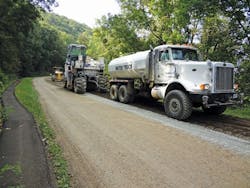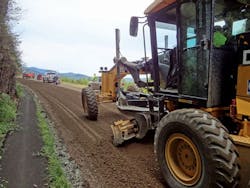Blue-tiful
The Blue Ridge Parkway is a scenic highway set high in the mountains of Virginia and North Carolina.
Unlike a standard highway that is optimized to carry the maximum number of vehicles from here to there, directly as possible and at high speeds, the Parkway was designed to showcase the beauty of its surroundings. Consequently, it has many sharp turns and steep grades along a meandering route that offers beautiful vistas across some pretty tough terrain. Both the road and surrounding land are owned and managed by the National Park Service (NPS) and limited access points are provided from “normal” roads. The NPS goes to great lengths to keep the environment surrounding the highway pristine and undisturbed. One might, therefore, appreciate the challenges a construction contractor would face in the process of rehabilitating this unique roadway—both in terms of appeasing the stakeholder and respecting the nativity of the site’s environs. Moreover, employing an aspect of environmental stewardship in the construction process itself presented its own particular challenges. The success of the Blue Ridge Parkway Pavement Rehabilitation Project was no small feat; as such it is the recipient of a 2016 Roads & Bridges/Asphalt Recycling and Reclaiming Association Recycling Award.
Normal vs. Parkway
“In a normal full-depth reclamation (FDR) project using portland cement, staging areas are arranged along the project site to transfer cement from tanker trucks to spreaders,” Stan Bland, pavement applications director for the Portland Cement Association’s Southeast region, told Roads & Bridges. “The spreaders lay the cement on the pulverized pavement prior to mixing and compaction. However, because of the special nature of the surrounding land [on this project], the spreaders had to be filled miles away at the bottom of the mountain, along a narrow, steep and curving road. Consequently, careful planning was needed to make sure the process was consistently supplied with cement and great care was taken to ensure that virtually no cement escaped the roadway.”
A 4,000-gal Kenworth water tanker makes its way down the Parkway trailed behind by a reclaimer.
There’s remote and then there’s remote. The Parkway qualifies as the latter. As contractor Slurry Pavers’ head of business development for reclaiming and stabilization David Stowell told Roads & Bridges, “Keep in mind, this road is built on the spine of a mountain.” As a solely recreational throughway, the road does not allow truck traffic. And while a typical highway will experience its highest traffic volumes during the work week, traffic on the Parkway peaks on the weekends, when recreational users are numerous. Thus, before even getting in to assess the situation and get down to work, crews had a time stricture on their hands.
“Work was allowed during the week,” Bland said, “but the Parkway had to be fully open and ready for tourists on weekends.” A point which Stowell quickly confirmed. “Weather was no excuse,” he said. “In order to accommodate visitors to the park, we had to have all reclamation and paving done by Friday afternoon, and if the forecast did not look favorable, we had to take that into account along the work week.”
Testing to know
According to Bland, prior to FDR with portland cement, the road is sampled to the planned depth of reclamation. The recovered material may include existing hot-mix asphalt, unbound granular base and subgrade. The mixture is taken to a testing laboratory and any large pieces are pulverized to represent the situation expected on the roadway.
This mixture is then tested for optimum moisture content and maximum dry density. Once those factors are determined, a range of cement contents are compacted at optimum moisture to maximum density and moist cured for a week. These samples are tested for compressive strength and the spread rate of cement is determined from the results. The selected cement content was based on achieving a seven-day compressive strength of approximately 400 psi. (The executive summary from Slurry Pavers called for a range of 300-500 psi.) Too much cement can result in undesirable cracking due to excessive shrinkage, so, in “Goldilocks” manner, it is necessary to select a cement content that is neither too high nor too low.
Cement content and target moisture and compaction values were then based on the laboratory testing. Of course, these values varied along the project, dependent on the variation in soil types and pavement condition.
“We were able to maintain 8 in. throughout the project,” Stowell said. “However, there were some variances in material. Some of the sections we found ‘boney’ [larger aggregate with little fines], down to almost a small fine stone, down to a red clay. Topography played a role in the variances. There were also a variety of materials used in the original road construction due to availability, location and logistics.”
“All man-made items vary,” Bland said. “It just depends on the precision of the measurement as to whether it is detectable. All base on this project was within the specified tolerance.”
The process
The quality control on the Parkway project was typical of FDR with portland cement. The cement spreader was frequently calibrated during the day using a sq-yd-size tarp to capture and weigh the cement being spread per sq yd. The depth of the mixing was likewise checked regularly. In particular, proper compaction is key to obtaining strength from FDR with portland cement. Accordingly, compaction was monitored closely using a nuclear density gauge to ensure appropriate strength and double-checked with compressive strength testing of cores. Also, the cross-slope and grade of the compacted base were monitored to ensure a smooth ride in the finished product.
“The reclamation process was done entirely in place,” said Bland. “The existing asphalt pavement and stone base were completely mixed and incorporated into the new, stronger base right there.”
Part of freshly surfaced ½ lane-mile.
A Deere 672G motor grader milled the base of the roadway.
The existing pavement was pulverized to the specified depth of 8 in. using a Wirtgen WR2500S reclaimer, typically for a distance of approximately 600-800 ft. Behind the reclaimer, a Deere 672G motor grader roughly shaped the pulverized base and made a small windrow on either side of the lane to hem in the raw cement during mixing. Once the pavement was pulverized and shaped, calibrated Kenworth cement spreaders went to work applying portland cement (with an allowable variance of 5% off testing rate). A Kenworth 4,000-gal water tanker was attached to the reclaimer and made a second pass to mix the pulverized pavement and cement, which was brought in from the mixing area at the foot of the mountain in a LBT Bulk Taker, or “Pig.” During this second pass, the reclaimer injected water at a controlled rate during the mixing to bring the final mixture to within 2% of optimum.
Once more, the mixture was roughly shaped with the 672G motor grader and compacted in a 1-2-3 pattern that employed a Hamm 3412P combination roller until the mixed base “walked out.” The Deere motor grader was then used to strike off the base and the surface was finished with a Hamm HD+120VP steel double-drum roller. Compaction testing was performed with a nuclear density gauge, and once compaction targets were verified, the reclaimed pavement was moist-cured overnight. Traffic was maintained on the completed FDR until the following morning, when the reclaimed road received its first layer of asphalt concrete surface.
Due to the weekday-only schedule as well as weather issues that can occur suddenly in a mountain climate, it was slow going.
“Typical productivity for this type of operation is approximately a ½ lane-mile per day,” said Bland. “However, the paving restraints on this project only allowed FDR work Monday through Thursday at noon. All FDR had to be surfaced with the first asphalt layer the following day. All operations then stopped for the weekend. So, the contractor could complete only ¼ to ½ mile of paving per week.”
Pressing on
“Logistics . . . the great obstacle,” Stowell said. “We were not allowed to stage on the Parkway, so we staged at the bottom of the mountain, 20 miles from the construction site. The nearest water source was a stream 23 miles away, so water had to be [siphoned] and hauled to the top of the mountain. During this time we had to satisfy the Department of Environmental Quality (DEQ) requirements. All cement was delivered, stored, and pulled from the same location, at the bottom of the mountain, also maintaining DEQ requirements. And the weather . . . well, it could be sunny in the valley but raining at the top of the mountain at the jobsite. You might have a perfectly sunny day and a dense fog would arrive and [force you] to halt operations. Every day was a new event.”
Coupled with spotty cell coverage and limited handheld radio dependability, crews pretty much had to make due with a tough situation for which there was no ready solution except to keep pressing on.
And so they did, and when all was said and done, the 12-mile, multi-county Blue Ridge Parkway Rehabilitation Project was completed in just under five months at a cost savings of approximately $2.65 million—all while curbing the environmental impact of the average road rehab project and revitalizing a crucial artery to some of Virginia’s most captivating landscape for, hopefully, another generation. R&B



